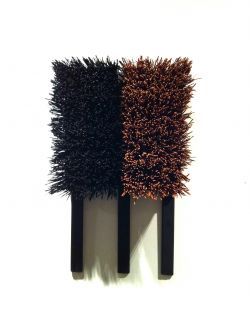ReVISION is an eclectic group exhibit that offers viewers a chance to reimagine the everyday. The show successfully balances individual artists' personal obsessions against the larger theme of re-imagining commonplace objects.
Curator and artist Lisa Cochrane's found-object sculptures are lurid and kinetic. Using animal skulls, bones, plastic furniture, rusted farm implements, wire and old clothing she creates zoomorphic creatures that seem to emerge from the modern unconscious – strange beasts that are part animal, part machine, part ghost-in-the shell.
“Snapped,” for example, is constructed out of two plastic deck chairs, bits of braided wire and pointed cow-hoofs. It is a giant clam-shelled, tentacle-d beast. Like all her pieces, it is cleanly constructed but emotionally hard to pin meaning to – save for being violent, vibrant and dark.
By contrast, artist Catherine Venart's pieces eschew all narrative. The three works shown are formal almost to the point of being inert. They are three vertical, linear structures of various sizes made from glass, copper and florescent pink-painted wood.
Although her pieces are difficult to engage with at an emotional level, they too have something to say about the materials that make up our social space. The fluorescent paint is a signifier of our public spaces – our cracked sidewalks when they are marked for repair, our trees when they are flagged for cutting, the helmets of construction workers who need to be seen on the job. Her delicate copper structure is a jewel-like representation of other small but meaningful objects – the wires that carry our currents in electronics, or the pennies that we lose in the street. Likewise, the glass sculpture evokes architecture: skyscraper windows, swimming pool ceilings, the small frosted blocks that emit light into public washrooms.
Michael Milligan offers viewers a chance to revel in ephemera with the “Somewhat round and thin series I and II.” These are collections of small found objects – fruit labels, lotto ticket stubs, prizes from cereal boxes, old paperclips, beer tabs, puffy stickers, food wrappers, etc. – displayed in individual slide-pouches and illuminated on glowing light-boxes.
At the July 4 opening, gallery-goers were especially enamoured by these works and clustered around the boxes like flies to honey. There is something engaging about these pieces, which let us look at the “useless” matter around us with new eyes.
Milligan's shoe series goes a step further into the obsession with waste by reclaiming the worn soles of old shoes. Displaying them numbered and tagged like archaeological finds, together with the story of their discovery (by himself or friends), he reframes our perception of the mundane.
NSCAD graduate Jay Dort offers a minimalist take on objects of different scale: a streetlight, desk lamp, and flashlight are lined up in a clean trio of crescents aptly named Sysygy (a word used to describe the sun, moon and Earth when lined up during an eclipse). Again what matters is the element of surprise – how unexpectedly lovely they all look together. Aren't our functional objects interesting?
Rounding out the exhibit are works by Emma Fitzgerald, Susan Malmstrom, Noah Logan, and Mellisa Schwegmann. Fitzgerald's pieces pay homage to the homely substances that she works with – plastic bags, face cloths, recycled denim.
Malmstrom's contribution is a coy intellectual gag. “The Repository of Wonders” is a fictional 19th century collection of archaeological “finds” and “treasures.” It parodies sham “museums” and the obsessions of useless record holders (I think of Ripley's Believe it or Not or the Guinness Book of World Records) by spinning its own unbelievable fictions within fictions.
Logan offers finely balanced enigmatic sculptures – “nunchucks” made out of hammers, a woodsman's axe frozen into a tree stump, a mop encased in cement. The objects are brutish and functional but playfully reimagined.
At the other extreme, Schwegmann offers us “Grid Cloud,” a luminescent sculpture made of chicken-wire panels and thread that resemble textbook statistical charts or enlarged slides for a microscope. The “embroidery” looks like preserved leaf skeletons and fine rootlets from plants grown in plastic packing.
Given this exhaustive catalogue of mysterious and strange objects, ReVISION is a surprisingly complex exhibition. While on the surface it appears to be united along a cohesive theme – recycled objects turned into sculpture – the content of each artist's work is rich and individual.
What the works do share is an impressive success at turning expectation on its head. The objects that you see are not the objects that you think you see; they have all been swept into a land of fantasy and nightmare. We are asked to look again at what we thought we knew and to start to reimagine what might be possible.
The ReVISION exhibit, with works by Lisa Cochrane, Jay Dort, Emma FitzGerald, Noah Logan, Susan Malmstrom, Mike Milligan, Mellisa Schwegmann and Catherine Venart runs at the Chase Gallery, in the Nova Scotia Archives, from July 4 to 30.



